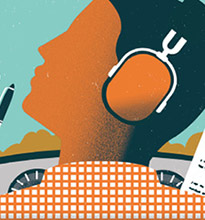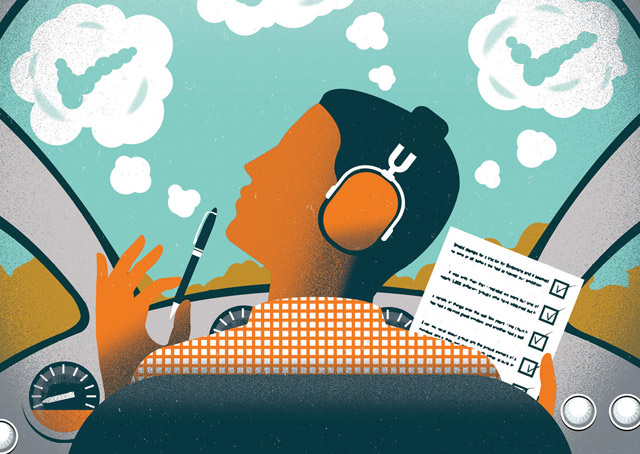Maybe a checklist should be a ‘think list’
Some older-technology airliners have as many as 76 items on the checklist forthe first flight of the day, according to a NASA study.
Pilots of all experience levels have been involved in fuel-starvation accidents after switching tanks during the prelanding checklist. At a time when the pilot is low, getting slow, and busy configuring the aircraft, the checklist reads something such as, “switch to fullest tank.” Many pilots just do it without a thought. Why? Because the checklist says so.
These incidents have made me reevaluate my thought process while completing a checklist from, “Do what it says and check it off,” to “Think about this and do what makes the most sense.”
Now, when I’m approaching to land and I see the “switch to fullest tank” item, I ask myself, “Do I have more than enough fuel to land and fly a go-around?” I’ve actually rewritten my checklist to say “check fuel quantity.” If the tank I’m using is half full, I won’t switch tanks. Why would you want to switch from a tank that’s been working properly to one that may have developed a blockage or has been leaking?
If the tank I’m using is slurping the dregs and the other tank is half full, of course I’d switch. But maybe I should have done that earlier, while I still had some extra altitude.
The point is to think about the checklist item, not just check it off mindlessly.
Zen and the art of checklists
I’ve flown with guys who run through their checklists in record speed, as if saying the words makes it so. That may be very Zen, but I don’t know how safe it is. A 1990 NASA study of the human factors that caused the improper use of, or failure to use, checklists reached a number of conclusions that any thinking person knows, but pilots often fail to heed. One was that there is a “relationship between the speed of performing the checklist and the quality (accuracy) of the check.” No surprise there—and yet many pilots still check off items at sonic speed, without pausing to think.
Most pilots would agree about the importance of checklists, but the NASA study found that without “witnessing the effectiveness” of checklists, pilots can be lulled into complacency. In other words, if you’ve run through your pretakeoff checklist a thousand times without incident, you’ll tend to perceive it as just a tedious task you’re required to do. But forget to set your takeoff flaps once and almost roll your aircraft off the runway, and you’ll earn a new respect for taking your time while completing the checklist—and ensuring that every item truly is correct.
There’s one item on checklists that pilots don’t seem to check off automatically: “lights—as needed.” Instinctively we think about which lights are needed during a particular flight, if any. Perhaps it’s the noon sun beating down on your head, or years of your mother telling you to turn off the lights when they’re not needed? I often use the strobe on my airplane, even during the day, but it’s an item I think about before flipping the switch.
Redundancy and ‘killer items’
As a primary student, I quickly found items on my checklist that seemed unnecessarily redundant. One was to set the directional gyro to the compass heading right after starting the engine. It never stayed correct during the taxi to the runway and I always had to set it again, so I thought, “It’s on the checklist again later, so don’t set it now.” I would give it a glance during the taxi to make sure it was actually working, though.
The NASA study, which focused on air transport aircraft but has valuable lessons for all pilots, discussed this duplication of checklist items. “Few airlines have opted to repeat several checklist items for redundancy and therefore reduce the probability of skipping an important item by the flight crew. Although this additional redundancy in the checklist might prevent an item from being missed, overemphasis of many items can degrade the crew’s overall checklist performance.” It’s easy to understand how a pilot would lose patience checking the directional gyro time after time while preparing to fly, and perhaps rush through the rest of the list.
Although experienced pilots have advised me not to create my own checklists—“They’ve been developed by the engineers who built the airplane; you don’t want to leave any item off”—I think I can make a better one, customized to me and my aircraft. I did consider their advice, and I only add or move checklist items. I don’t remove an item completely unless it’s not relevant, perhaps because I don’t have a particular piece of equipment in the aircraft.
On the other hand, there are items of such importance that the NASA study stated, “Duplication of a very few highly critical items (‘killer items’), that are based on possibly transient data, can be beneficial.”
It might be an understatement to say that double-checking anything called a “killer item” could be “beneficial.” The study was primarily concerned with items such as flap settings and takeoff speeds, which are calculated according to variables such as weight, weather, and runway length—and could change during the start-up. My airplane isn’t quite so complex, but I’ve added a “killer list” to the end of my checklist, too. I check those things that could cause a loss of power or control again right before I roll onto the runway: trim for takeoff, carb heat off, fuel on, mixture rich, primer locked. It only takes a moment.
Checks not accepted
Maybe the term check should be replaced by words that provoke more thought. “Check” seems to encourage pilots just to confirm that it’s there—whatever “it” is—and not ask, “Is this correct?”
The NASA study found that “many checklists examined by the authors employ the ambiguous responses, ‘set,’ ‘check,’ ‘completed,’ et cetera to indicate that an item is accomplished. Instead, we believe that whenever possible, the response should always portray the actual status or the value of the item.”
For example, perhaps a checklist should read “oil pressure 50 to 90 psi?” instead of “oil pressure—check.” You could mentally, or even out loud, read “oil pressure 50 to 90 psi?” and deliberately read the gauge and respond to yourself, “65 psi, good to go.”
As I read any checklist item, I now say to myself, “What’s the best action to take concerning this item?” Would it be smart to switch tanks or better to continue on the current one? What is the oil pressure, and is that reading sensible? Should I use the landing light or strobe during takeoff? Don’t forget to complete the task once you’ve made your best decision. That’s important, too.
Perhaps instructors should teach checklists as “think lists.” Thinking takes longer than checking, and new student pilots must be taught to slow down and think about each item before they check it off.
Dennis K. Johnson is a freelance writer and pilot living in New York City.
 Your checklist checklist
Your checklist checklist
• Use the appropriate checklist for your aircraft
• Take your time
• Think about each task, don’t just “check it off”
• Call out the proper reading or setting
• Double-check the “killer” items



